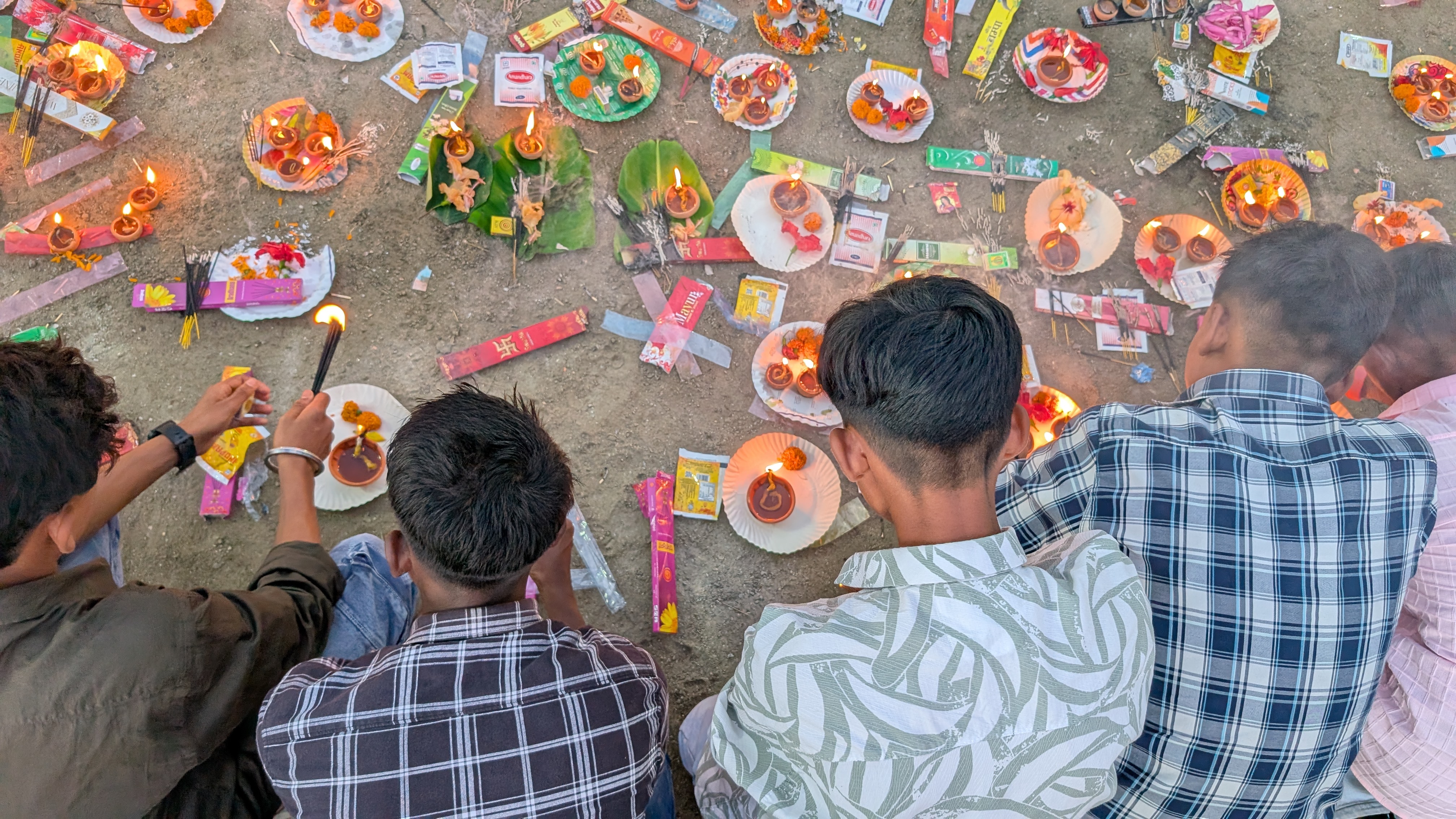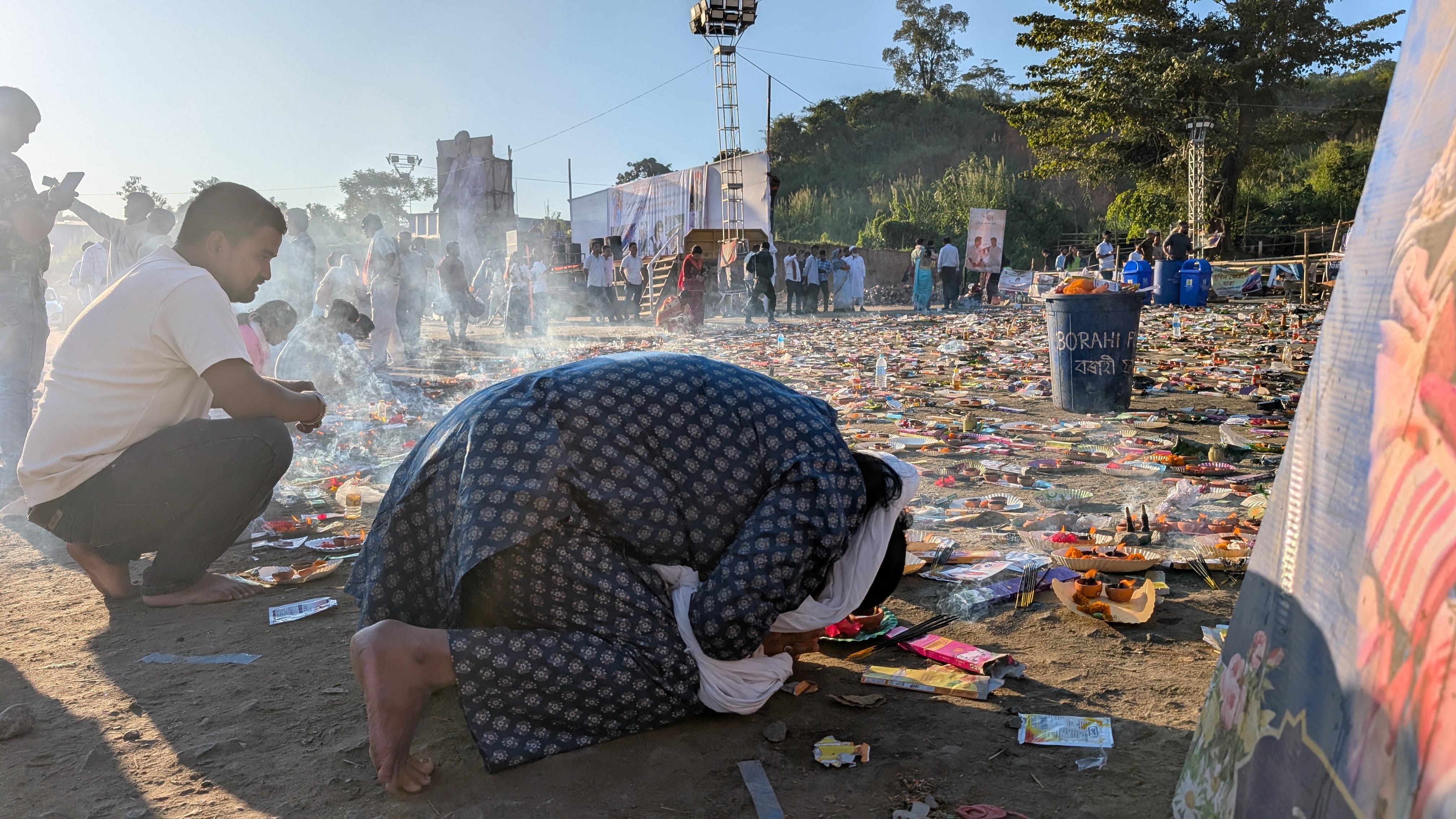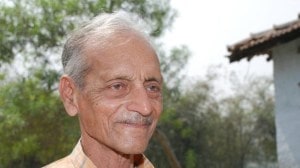Two months after Zubeen’s death, his cremation site turns into a shrine: ‘I feel at peace here’
The atmosphere at Zubeen Kshetra is a mix of fair and shrine. The site is strewn with banners, posters and gamosas – tokens of reverence left behind by his fans
 In this environment, Zubeen’s cremation site draws those grieving, those angry and those just curious.
In this environment, Zubeen’s cremation site draws those grieving, those angry and those just curious.
ON SEPTEMBER 23, Nabanita Bordoloi had watched from behind the curtains of her home as Assamese singer, superstar and cultural icon, Zubeen Garg, was cremated amidst a sea of mourners at a ground near her home. But the crowds never stopped. Two months on, this site – a public cremation ground that has been christened Zubeen Kshetra – continues to draw hundreds of visitors every day and has transformed into the beating heart of a restless state.
Most mornings for Nabanita now begin with sweeping and picking up litter and remains of offerings – marigold and hibiscus, burned up incense sticks, blackened saki (clay lamps) – left behind by visitors at the 3-acre plot in Sonapur, around 16 km from Guwahati.
The atmosphere at Zubeen Kshetra is a mix of fair and shrine. Adjacent to the enclosed area where Zubeen was cremated, visitors kneel down with paper plates laden with gamosa, incense sticks, flowers and saki to pray and make their offerings. The air is thick with the smell of incense sticks that burn in unison. This devotional area is flanked by two towering cut-outs of Zubeen dressed in a gleaming lavender suit, his look completed by Ozzy Osbourne-esque sunglasses and a chunky gold neckpiece. Outside the perimeter of the field, vendors selling cotton candy, ice cream, balloons and faux peacock feathers stand side-by-side with stalls selling prayer paraphernalia and framed photographs of Zubeen.
 The site is strewn with banners, posters and gamosas – tokens of reverence left behind by groups that made the jatra (journey) to Zubeen’s resting place.
The site is strewn with banners, posters and gamosas – tokens of reverence left behind by groups that made the jatra (journey) to Zubeen’s resting place.
The site is strewn with banners, posters and gamosas – tokens of reverence left behind by groups that made the jatra (journey) to Zubeen’s resting place. One banner adorned with Zubeen’s photos declares that a ‘bank mitra’ association from Golaghat had travelled 260 km to the ‘shrine’; another simpler banner says that workers from Longboi Tea Estate in Dibrugarh district, 410 kilometres away, had visited on November 15; yet another declares that residents of Maharipara village in Tamulpur district, 80 km away, were at the ground on November 14.
Tutumoni Das, 35, leans against one of these banners with her three-year-old son in her arms. She lives nearby and makes it a point to come here nearly every week. “There’s something about the poribex (environment) here. When I come here, I feel at peace… like the peace I experience at a temple or naamghor (prayer centre),” she says.
Most visitors make similar temple references. “This is actually a smoxan (cremation ground), after visiting which people would bathe. But we bathe before coming here because it is like a temple,” says 37-year-old Arup Rajbongshi. It is a Tuesday and he has taken a day off from his job to travel from Mangaldoi, a 2.5-hour drive away, for what he says is his sixth visit to the site.
 In this environment, Zubeen’s cremation site draws those grieving, those angry and those just curious.
In this environment, Zubeen’s cremation site draws those grieving, those angry and those just curious.
‘Zubeen da feels alive’
Since Zubeen died at age 52 while swimming in Singapore on September 19, the state has been consumed by a wave of grief, longing and even rage over his untimely death. The rallying cry of “Justice for Zubeen” runs strong even after two months and the state continues to be a cauldron of emotions that refuse to subside.
While the government continues to promise the restive public a coherent case pinning his arrested associates – including his manager, bandmates and the organizer of the festival for which he was in Singapore – for murder, the Opposition hopes to mobilise the emotional outpouring in the state ahead of next year’s election.
In this environment, Zubeen’s cremation site draws those grieving, those angry and those just curious.
“Zubeen da feels alive in this place, with so many people here together just for him,” says Meghali Gogoi, 32, who is here with a group of women from the nearby Rongdoloi village, distributing bottles of water to visitors.
 At the site
At the site
Her group had come to the site a couple of weeks ago to sing naam (devotional songs) – an enclosure at the site has been set aside just for this purpose.
Ziaur Rahman, 50, is here with his children and grandchildren from Hajo, around 50 km away. “This is my first time here. We have all been wanting to come but it was difficult to get away from work,” says Ziaur, who works as a driver. “But the one who pushed us the most to come was my grandson, who has been continuously watching videos about Zubeen and this place on my mobile phone.”
At the site are a group of children, aged between 12 and 14 and dressed in blue and green uniform t-shirts. They are students of a coaching centre in Morigaon town, around 60 km away, and are accompanied by their teacher Neha Barbhuiyan, who says she wanted them to have “an important cultural experience”.
“The children have been completely swept up with everything that’s happening in the state. So our principal said, let’s bring them here so that they can connect and experience this. They sing Mayabini nearly every day before class begins!” she says, referring to one of Zubeen’s iconic songs, which has turned into a hymn after his death, played on loop at every memorial, including this one.
 A woman at the site
A woman at the site
Amidst the hurly-burly of daily visitors, construction work is on at the site on a memorial being planned by the state government. Yet, the site is a deeply private space, its autonomy guarded closely by the general public who frequent it and who have come forward for its upkeep.
“People from nearby areas have been coming forward to clean and maintain the space. The cremation ground here was more than 100 years old. When it was decided that it would be given to Zubeen da, the people decided to come together,” says Mrinal Gayan, 52, a resident of Kamarkuchi, who is part of a local committee that has been set up to maintain the space.
This autonomy also extends to the way people experience the space: the crowds swell after dark and many visit after they are a few drinks down.
In late October, when the state tried to intervene by issuing a set of regulations for the site, limiting the hours of entry from 6 am to 10 pm and disallowed the entry of people under the influence of alcohol or other intoxicants, it was met with outrage. The backlash forced the state to extend the visiting hours to 11 pm.
 A woman praying at the cremation site
A woman praying at the cremation site
“We don’t need any SOP from the government telling us how and when we should be with Zubeen da,” says Nayanmoni Das, 40, a resident of the nearby town of Khetri, who is busy at work with his wife and five-year-old son, clearing older plates of offerings from the ground. It is his fourth visit to the site. “When I come, I do some work for the place too. Us anuragi (fans) look after this place, and here it feels like dada is among us. What we want from the government is justice for dada,” he says.
‘No Hindu-Muslim here’
In a state with a fragile and complex social fabric, the love for Zubeen – and the belief that he was wronged — seem to have, at least for now, papered over many other differences. Chief Minister Himanta Biswa Sarma has, however, attempted to bring religion into the mix.
On multiple occasions now, he has declared that ‘miyas’ – a pejorative term used for Bengali-Muslims – are ‘fake supporters’ of Zubeen.
“When Zubeen Garg died, Durga Puja had taken place. In front of every pandal, every Hindu family had put photos of Zubeen in shraddhanjali. Then there was the Raas festival, Lakshmi pooja, and we saw the same thing there. But their ijtema (public gathering) has been happening, their dharma sabha. But in not a single ijtema have we seen Zubeen Garg’s photo. That means that Assamese people should understand one thing, that ‘doubtful’ people will not keep Zubeen alive, only Assamese people can keep Zubeen alive,” he said speaking to reporters last week.
Shah Jahan Ali, 40, who was visiting Zubeen Kshetra that Tuesday with his friend Achanur Ahmad, 25, from Baihata Chariali, 50 km away, shrugs this off with a smile.
“We have been fans of Zubeen da ever since we can remember. There is no question of Hindu-Muslim here. Himanta mama may have said this because of politics, maybe because it’s not good for his party if Hindus and Muslims become one on an issue. We are just here to seek peace, because we have not been able to do anything for dada,” he said.




- 01
- 02
- 03
- 04
- 05



























